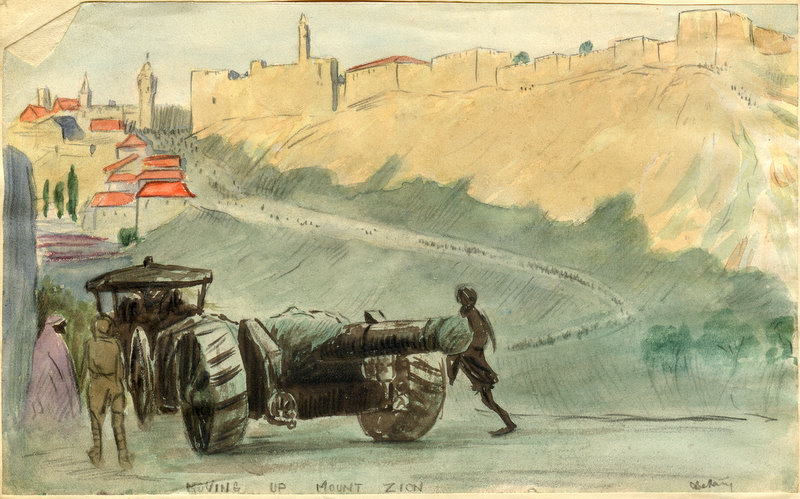WW1 Batteries Moving Up Mt Zion 1917
 Moving up Mt Zion
Moving up Mt Zion
In the foreground a heavy artillery piece is being pulled by tractor along a road. The road leads round to Jerusalem with Mount Zion on the right. More figures can be seen winding their way along the road in the distance, leading to the Jaffa Gate.
‘Batteries Moving Up Mt Zion’, 21 December 1917, was originally painted by James McBey, and we assume Des painted this from published works perhaps gained at the Singapore Library. A quick search reveals that McBey produced a number of books from 1914; 1924; 1927;1936 of his etchings and paintings. The original of the McBey’s art above is held by the Imperial War Museum, UK.
From The National Arts & Lifestyle an article entitled:
“The conflict images of the underappreciated First World War artist James McBey” byAlasdair Soussi written on reveals the following:
“For many of today’s war artists, McBey’s (1883 – 1959), contributions are undoubtedly worthy of study – and of extreme admiration.
One of the greatest British etchers of the 20th century, James McBey’s prints, together those of fellow Scots David Young Cameron and Muirhead Bone, provide a vital link between the etchings of James McNeill Whistler, the early years of etching revival and the phenomenal ‘boom’ in the etching market during the 1920s—a period when more etchings were made, editioned, published, exhibited, sold and resold than at any other time.
He went to Egypt as official war artist in May 1917 and for the next 18 months he documented troop activities and the landscape. He travelled widely along the Suez Canal area, into the Sinai Desert with the Australian Camel Patrol of the Imperial Camel Corps and accompanied the Allied advance through Palestine from Gaza to Jerusalem and on to Damascus.”
During this arduous trek, McBey found himself etching and painting some of the most seminal moments – and characters – of the Arab campaign. The likes of The Allies Entering Jerusalem of December 1917 and his Damascus portrait of a gaunt T E Lawrence during his final days with the Arabs in October 1918 – a sitting that was constantly interrupted by a steady stream of sheikhs who knelt before the iconic Brit and kissed his hands in tearful goodbyes – were just two of his many striking contributions to documenting a war effort that repeatedly forced the self-taught Scottish artist to adapt to his surroundings.”
Source: http://www.thenational.ae/arts-culture/art/the-conflict-images-of-the-underappreciated-first-world-war-artist-james-mcbey#full
https://www.aber.ac.uk/en/art/gallery-museum/collections/artist-collections/mcbeyjames/

